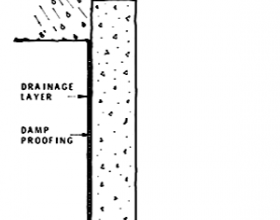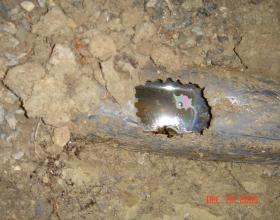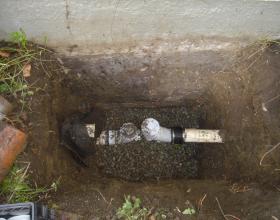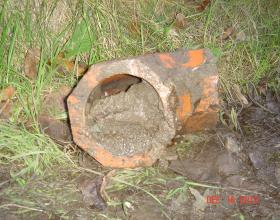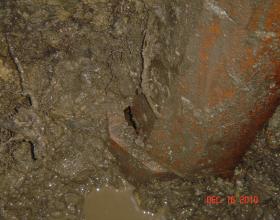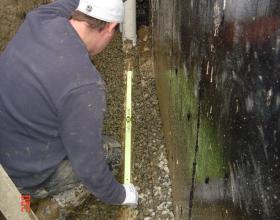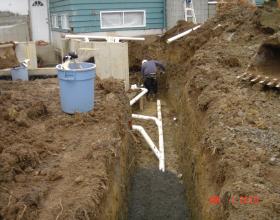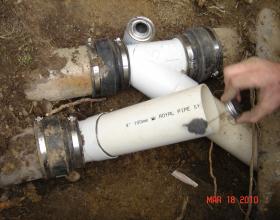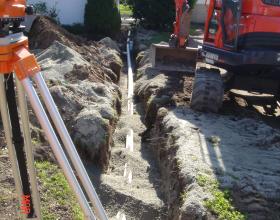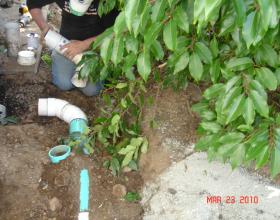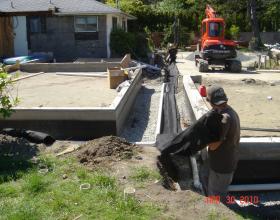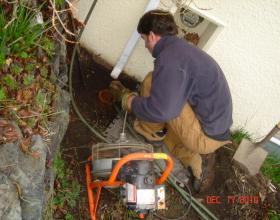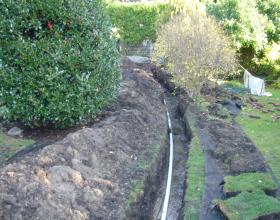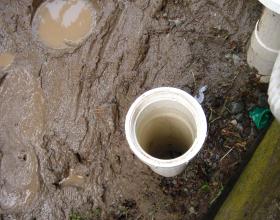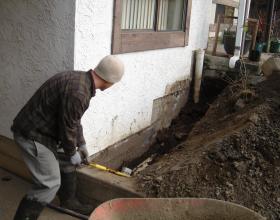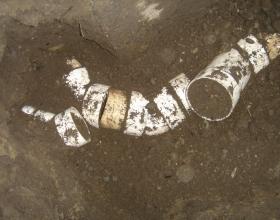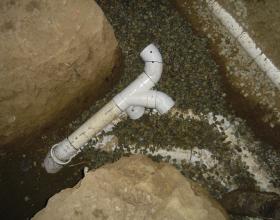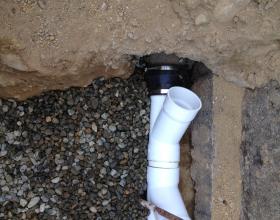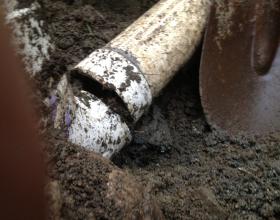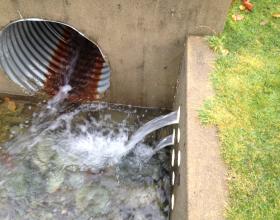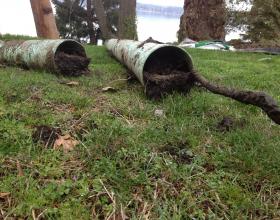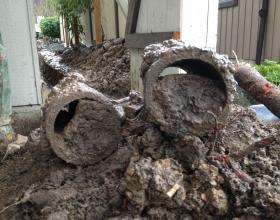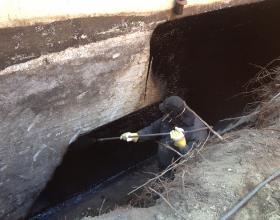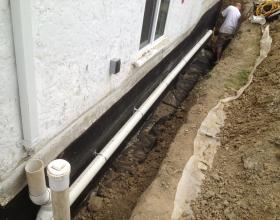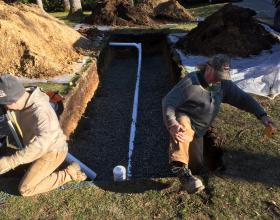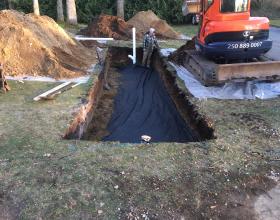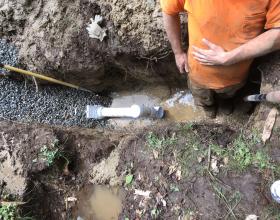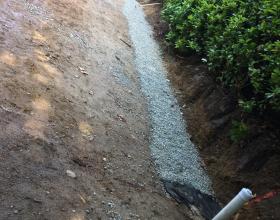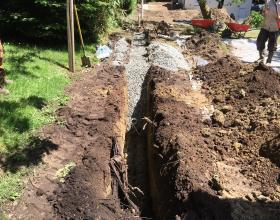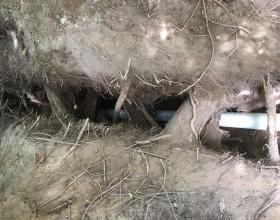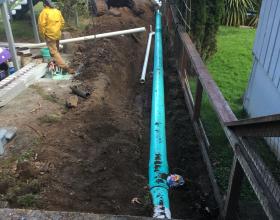Victoria is a city with many older homes. In years past perimeter drain systems were done differently and with a much higher level of built-in failure resulting in flooding of basements and crawl spaces. When the old clay and concrete perimeter drain tiles collapse, roots and dirt clog the drain; the basement has no drainage protection and the basement floods. Basement and floor perimeter drainage is essential for protection of your house or building foundation. Without an adequate perimeter drain and waterproofing, flooding and erosion problems will cause very costly repair bills and reconstruction may be required.
Pacific Group Developments has specialty equipment just for installing and repairing perimeter drains. Our team is fully trained to ensure compliance with provincial drainage requirements and the building code for perimeter drains and rain water leaders.
Wet basement problems and waterproofing
Nothing is more frustrating than dealing with a wet basement. It can damage walls and flooring and ruin irreplaceable things you are storing. But knowing the causes of wet basements and how to prevent water damage can help avoid this frustration.
There are four common sources of water that seeps into basements:
- Surface water running down foundation walls
- Groundwater in water-saturated soils being pushed into the basement by hydrostatic pressure
- Storm sewer water from the municipal storm sewer system backing up into the home's existing perimeter foundation drain and leaking into the basement (this can only occur if the perimeter foundation drain system is connected to the municipal sewer system)
- Sanitary sewer water from a combined municipal storm/sanitary sewer system backing up into the home's perimeter drain system, causing sewer water to come up through sink drains and floor drains on lower levels
When homeowners experience wet basements for the first time, it is imperative to determine if the water problems are going to reoccur or if it was a one-time event.
The failure of a perimeter drain can have a disasterous affect on your foundation and basement. Cracking of the foundation walls or floor may be an early indicator of major problems to come. Replacing or repairing an old drain may require trenching to the level of the foundation the entire length of the foundation. Consult with Pacific Group Developments as soon as you notice any cracking no matter how minor it seems. We will assess and advise you of the work required with as little inconvenience to you as possible. We have the right tools, the expertise and the experience to do the work on time, on budget.
Controlling surface water
If this is the first time for basement water problems, the first thing to check for is surface water draining down next to the foundations. Water coming in at one location and only at the exterior foundation wall are typical indications of surface water problems.
Here are some things to look for:
- Are the gutters overflowing because they are blocked with leaves? Keeping gutters clean of debris should be a part of every homeowner's routine maintenance program. Depending on the surrounding trees, gutter cleaning may be required a few times a year. Products are available to prevent leaves from getting into the gutters.
- Are gutters overflowing because there are not enough downspouts on the house? If you don't mind getting wet, you can do a self-check (your gutters must be cleaned out first). After at least 15 minutes of heavy rain, check your gutters. If you see any water overflowing, you have a problem. Any water overflowing out of the gutters is running down next to the house foundations. Even if the water is not getting into the basement, it could be causing unseen problems like eroding soil from under the house footings, which can lead to cracking of walls and ceilings. The easiest solutions to overflowing gutters are to either add another downspout on that run of gutter or to increase the size of the downspout. The best solution between these two is probably adding another downspout because the second downspout can act as a back-up if the other gets blocked. However, if you choose to replace the existing downspout with a larger one, make sure the contractor increases the size of the corresponding hole in the gutter. It doesn't do much good to install a larger downspout if the gutter hole is left small.
- Do the downspouts extend at least 10 feet from the home? While many homeowners do not like downspouts extending out this far, 10 feet is the minimum distance needed to discharge water coming off your roof far enough away from the house. Be careful not to discharge downspouts too close to your neighbor's property. Most towns and cities have ordinances that prevent downspouts from discharging too close to the property line and causing water problems for neighbors. Your local building safety or inspections department can provide you with the minimum distance.
- Do the downspouts drain into the footing tile system? It was common practice in the first half of the 20th century to have the downspouts draining into the footing tile system around the house. Vertical tiles were installed up from the footing tile system at each downspout location and the downspout was inserted into the open end of the tile. Sometimes the gaps around the downspout were mortared shut. Having the water from the roof drain down next to the footings can add to hydrostatic pressure problems, especially if the footing tile is leaking or blocked. This can occur over time due to soil movement or damage from tree roots. If the downspouts are draining into the footing tile system, the downspouts should be modified so they drain onto the ground and discharge at least 10 feet from the house. The vertical tile should be capped with a preformed cap or concrete.
- Are there any paved areas next to the house that slope toward the house? Sometimes paving settles over time and water flow can change direction toward the house. If this is the case, the paving should be removed and replaced so it slopes away from the home.
- At paved areas that abut the house, is there sealant in the joint at the pavement-house wall intersection, and if so, is it cracked? Sealant sometimes cracks over time due to age or incorrect installation. If the sealant is cracked, the cracked sealant must be removed and replaced with new.
- Is the ground around the home sloping away from the home at least 10 feet? Look for any depressions in the ground next to the home foundation walls. If any are found, fill in with dirt so the water drains away from the house. Use a clay-type soil that sheds water instead of sandy soil that allows water to soak into the ground. Make sure that at least eight inches is kept between the top of the earth and any wood or stucco on the house. If this cannot be done, the house may have been built too low and to correct it may be too expensive to be feasible.
- Are there any hills sloping down toward the house that may be the source of the water? If this is the case, a civil engineer may be required to analyze the situation and determine the appropriate solutions.
- Is there a lawn/shrub irrigation system discharging too much water next to the house? Avoid placing lawn irrigation next to the house. If this cannot be avoided, instruct the installer to limit the amount of water dispersed next to the house. Make sure the irrigation system includes a working rainstat so the system does not turn on when there has already been plenty of rain for the plants and lawn.
Controlling subsurface groundwater
If no surface water sources are found, then the source of the water is likely subsurface groundwater under hydrostatic pressure. Unfortunately, subsurface groundwater problems are more difficult and more expensive to fix than surface groundwater problems.
When the groundwater levels outside the basement rises above the level of the floor, the basement acts like a boat in a pond. If a boat is sitting in water, water will leak in through any open cracks or holes. It works the same way with a basement. Hydrostatic pressure can push water through hairline cracks.
Symptoms of this are water coming up through cracks in the basement concrete floor or water coming in at multiple locations.
If you have an older house within town and the house has a basement with no sump pump, it is likely the perimeter foundation drain system connects directly into the city storm sewer system. If the level of the basement is below the street level, there is the potential of storm water backing up in the city storm sewer system and being pushed into the perimeter foundation drain system. This can saturate the soils around the house at the basement level with storm water under hydrostatic pressure, causing water to leak in.
Another source of subsurface groundwater is an underground spring.
No matter where it is coming from, the best way to control subsurface groundwater is to install some type of perimeter drain system to relieve hydrostatic pressure. The groundwater is pushed into the drain system and not into areas where it can damage carpets, walls or belongings. The water drains by gravity into a sump pit where a sump pump discharges it out of the house.
There are two basic types of drain systems for wet basements. One is a perimeter above-slab gutter system installed at the base of the exterior foundation walls on top of the floor slab. It doubles as a base material for the wall. The other type of drainage system is a below slab perimeter drainage system. The below slab system requires the partial removal of the concrete floor slab and installation of drainage pipe making it more expensive than the base gutter system.
It is believed that an under-floor drainage system is better because the under-floor drains are believed to relieve the hydrostatic pressure before the water reaches the bottom of the floor slab.
Storm water backing up into your home
In many older houses with basements (mostly pre-1980), there is a perimeter foundation drain outside the exterior wall, at the level of the basement floor, next to the footings at the time the house was built. A pipe was usually installed from the perimeter foundation drain to the street where it was connected to the city storm sewer system.
This can become a problem as the city storm sewer system becomes too small when more development causes more rain runoff. When this happens, the rainwater in the sewer system can get so high that water flows backwards toward the house. The perimeter foundation drain fills with water and releases large quantities into the soil next to the footing and basement floor. The soil becomes water-logged and the water which is under hydrostatic pressure leaks into the basement.
Usually the installation of an interior perimeter basement drain system connected to a sump pump will take care of the problem. The interior perimeter basement drain system can usually pump the water out and onto the ground as fast as the water is backing up from the city storm sewer system.
If that doesn't take care of it, the other, more expensive alternative would be to dig up and cap the pipe that is running from the house to the street from the perimeter foundation drain. However, this is not always possible because many times, this pipe is also draining sanitary waste from toilets and sinks in the house.
If you believe you have this problem, contact an experienced contractor for advice.
Sanitary sewer water backing up into your home
If the water is coming up through floor drains or sink drains in the basement, then the problem is likely water backing up from the municipal sanitary sewer system. This usually occurs in older sections of some cities that have combined sanitary and storm sewer systems. During heavy rains, combined sewer systems can become overwhelmed with water. This can cause sewer water to back up in the system and sometimes into homes.
You can imagine the mess this creates for homeowners because it usually means they are getting other people's fecal waste backing up into their basement. To correct this, cities should update their sewer systems so the sanitary sewer and storm sewer are running in separate pipes. Until this work is complete, the homeowner can install backflow preventers that help stop sewer water from flowing backward into the house.
Unfortunately, because the city sanitary system works in conjunction with every house sanitary piping, the backflow preventer usually cannot be located on the house's main sewer line. It usually requires several backflow preventers at all basement drain locations, such at every floor drain, sink and toilet.
These backflow preventers require routine maintenance to make sure they are kept free of debris.
French Drain
French drain, Curtain drain and Interceptor drain are all pretty much the same thing. They all catch water and remove it to protect the area from excess water. A French drain/Curtain drain may be a solution to redirect water if you have standing groundwater on your property. This can help keep water out of your foundation and eventually your basement. While this is not a complete cure all for all potential water problems, a French drain/Curtain drain can be a good solution if water gathers on your yard near your foundation and does not drain properly.
Standing groundwater is usually a problem when grading is not constructed properly around your home. If the slope is not correct, ground water will collect near or run towards your home’s foundation. This can be detrimental in more than one way. The most obvious is that this water can infiltrate your basement causing damp conditions if not thoroughly flooding your basement at times. In addition, and usually less obvious until major damage has occurred, this water can actually undermine the integrity of your foundation walls. At this point, your whole house is in jeopardy, not just your basement.
Our team is knowledgeable, prompt and courteous and understands the impact of basement flooding with the expertise to correct the problem at competitive rates.
Drain Cleaning Victoria
Drain cleaning in Victoria is a very important part of a home maintenance program.
Most of Victoria has old homes with old drain tiles forming a perimeter drain system protecting the basement from flooding.
We provide effective drain tile cleaning by flushing the perimeter drains with a hydro jet, this system is preferred for both agitations and flushing out sediment which has accumulated in old drain tiles.
The use of a hydro jet is also much safer than the alternative which is a roto drain auger which commonly breaks old delicate drain tiles. Additionally, our hydro jet system is smaller allowing it to go further in the drainage system and flush out everything behind it.
With proper maintenance perimeter drain flushing will prevent or postpone the need for drain tile replacement which is much more expensive.
Sometimes when a perimeter drain system fails it is due to a small blockage in the drain tiles, often times a drain cleaning can be done quickly and cost effectively by hydro jetting.
Call us today to inquire about our drain cleaning services.
Leaking Basement
Leaking basements are a common problem. All homes are exposed to water sources such as surface water like rain flowing down to the aquifer, an underground stream or the water table itself. For many years, weeping tiles have been placed at the bottom of homes’ foundations, near the footings, to carry this water away from the house to the municipal storm sewer buried in the street. Weeping tiles, or drain tiles/perimeter drains, are meant to direct all groundwater, whether it’s sourced from the surface or below ground, away from your home through the use of gravity. Water will always flow through the easiest available route. By sloping the drain tiles/perimeter drains away from the house, an easy path is provided for water to flow away from your house, which is what you want. As long as it’s easier for the water to flow away from your house than into the concrete wall of your basement, water shouldn’t get into your basement.
Problems can occur if there’s a blockage in the drain system, broken drain tiles or a crack in the foundation. Concrete is a porous substance, and water can pass through it. Water seepage in the basement or dampness can be a sign that excess groundwater is no longer draining efficiently away from the house. If it’s easier for water to pass through your basement than into the drainage system, or if it has nowhere else to go, then that’s what it will do. The solution to all these issues is to get the excess ground water flowing away from the house.
In past years, drain tiles typically consisted of short lengths of clay tubing butted up against each other. Water would access the tiles through gaps between the tubes and flow away. But clay drain tiles crush and break over the years from pressure, and tree roots can also grow into and through the tiles, breaking or shifting them. Soil can also shift and move from frost and freeze and thaw cycles, which can disturb the drain tiles so they no longer connect properly. Older clay weeping/drain tile systems tend to last only a few decades before they are compromised and will no longer work properly. Today, weeping tile systems typically use four inch PVC pipes that have small holes throughout to allow water to seep into the pipe. Pipes are often covered with a filter cloth to stop soil and other debris from filling and blocking the pipe over the years.
Water shouldn’t be leaking into your basement, but if it is, there’s an excellent chance your drainage system is the culprit.

